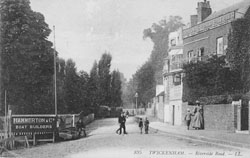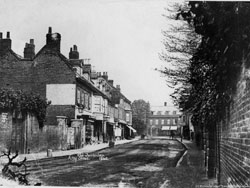Twickenham Pubs
Coaching inns opened in Church St and King St to serve travellers.


During the 18th century two inns catered for the coach trade through King Street. The George from 1709 and The King's Head (previously The Feathers) from 1726. They were the two largest public houses in the parish in 1818; each with extensive yards for stabling covering nearly a third of an acre. They were staging posts; The King's Head, on the south side of the street served coaches from London while The George, nearly opposite, served those going towards London. The George, with its yard converted to a patio, is still there but the old King's Head was demolished in 1926 when King Street was widened. A replacement built in the garden behind the old building was later renamed The Bird's Nest. It closed in 1970 and shops now occupy the site. These shops are likely be demolished as part of the Twickenham Riverside Development

The Crown at 174 Richmond Road is mentioned in 1730. Other inns with their origins in the 18th century, included The Red Lion (recently converted to house a Tesco's store) and The Three Kings in Heath Road. Another was the Royal Oak at 13 Richmond Road at the corner with Oak Lane which is mentioned in 1723. The Eel Pie Island Hotel burnt down in 1971 during demolition but there had been an inn on the site since at least 1729 and quite possibly a lot longer than that. It was initially called The Ship, and later The White Cross on the Ayte. The old premises were replaced in 1830 and became a popular Victorian resort capable of accommodating parties up to two hundred people. In the 1960s it became a club for popular and jazz music and many groups including the Rolling Stones and Black Sabbath played there. Houses now occupy the site.

Between 1760 and 1820 only a single licence was granted, in 1815, for The Prince Blucher at 124 The Green, but this was counterbalanced by the closure of The Post Boy in London Road. In 1818 there were some 20 public houses and inns in the parish. In 1830, the Beer House Act, provided impetus: by 1845 there were 22 together with 37 or so unlicensed (by the magistrates) premises popularly known as 'Tom and Jerry shops'. These were abolished by an Act of 1869 which transferred responsibility for the beer houses to the licensing magistrates. Even so, in 1871 there were at least 57 inns and beer houses

The Beer House Act permitted any householder to sell beer and cider after obtaining a license from the Commissioners of Excise and so many beer houses opened, some eventually being fully fledged public houses. Among the first of these were The Rifleman in Fourth Cross Road, The Turk's Head in Winchester Road (mentioned as a beer house in 1855 and rebuilt in 1902) and The Five Oaks at 209 Staines Road (a beer house in 1837, licensed by c1880 and now called The Bloomsbury). Another in Staines Road, at No 15 near the Prince Blucher, was The Sussex Arms (originally an 1837 beer house).

As Twickenham expanded along the main roads new public houses were opened: The Rising Sun in Richmond Road (by 1841), The Prince of Wales along Hampton Road (c 1850) and Pope's Grotto Hotel in Cross Deep (1853) which was bombed in 1944 and then rebuilt. It has twice been extended and refurbished in recent years and renamed The Alexander Pope.
The coming of the railways led to an increase in the number of pubs. In Twickenham three 'railway' pubs opened; The Albany Hotel (1860s), The Railway Hotel (opened 1853, closed in 1962 and demolished) and The Railway Tavern (opened 1853 and now called The Cabbage Patch).
By 1900 the number of public houses had risen to 35 with 30 beer houses. In the 20th century The Fountain was built in 1939 in Staines Road. This, with its large car park can be described as a Road House: the modern equivalent of an old coaching inn.



